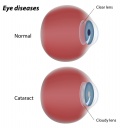Cataracts
|
Cataracts | |
| Causes | Posture, Alcohol, Trauma |
|---|---|
| See Also | Head, Ears, Eyes, Nose and Throat Conditions, Macular Degeneration, Glaucoma |
| Books | Books on Head, Ears, Nose and Throat Conditions |
| Articles | Articles on Head, Ears, Eyes, Nose and Throat Conditions |
A cataract is an opacity or clouding of the crystalline lens of the eye. Cataracts can cause vision loss and can be potentially blinding if left untreated. They are therefore the leading cause of blindness in the world.
Naturopathic Assessment
Causal Factors
In order to stimulate the innate ability of the body to heal the causes of disease must be identified and addressed. With cataracts, the causes are variable and include poor posture, alcohol, trauma and other factors. A detailed assessment is required to determine which factors are contributing to Cataracts.
Lifestyle
- Poor posture can be found to increase the risk of cataract formation.
Social
- Occupation
- Persons in occupations or activities exposing them to possible eye trauma and specific types of radiation may be at increased risk for developing cataracts [2]
Environmental
- Sunlight
- Excessive exposure to sunlight has been linked with cataracts.
- Climate
- An increased incidence of cataract has been reported in persons living at high altitudes and in climates with high levels of ultraviolet radiation [2].
External
- Trauma
- Previous eye injury or inflammation can lead to cataracts.[2].
- Smoking is associated with an increased risk of cataracts.
Medical Interventions
- Medical Interventions
- Exposure to ionizing radiation, such as that used in X-rays and cancer radiation therapy can increase the risk of cataracts.
- Previous eye surgery has also been linked to cataracts.
- Prescription Medications
- Prolonged use of corticosteroid medications increase the risk of cataracts [2].
Diagnostic Testing
In adults, a slit lamp examination will help identify cataract formation as the cause of slowly deteriorating vision or clarity of vision. In neonates, a bilateral eye examination, including examination of bilateral red reflex can help to effectively rule out cataract. A visual acuity test is also done to assess the degree of myopia (nearsightedness) or hyperopia (farsightedness) that the patient may be experiencing.[2].
Related Symptoms and Conditions
Cataracts are more common when the following conditions are present:[2]:
- Type II Diabetes
- Type I Diabetes
- Down syndrome
- Werner syndrome
- Myotonic dystrophy
- Atopic dermatitis
- Hypertension
Characteristics
Although cataracts can occur at any age, the peak ages for cataract development are the first decade of life, which is congential, and over the age of 65, which is more age-related. Age-related cataracts are found to be the most common, occurring 90% of the time. Cataracts may be unilateral or bilateral, where bilateral cataracts do not necessarily impair vision in both eyes equally. They usually develop gradually over the years, and progress painlessly.[2].
Common Symptoms
Symptoms of cataracts include[3]:
- Lens opacity
- Cloudy, blurry, fuzzy, foggy, or filmy vision
- Loss of colour intensity
- Double vision or multiple images in the eye
- Difficulty seeing at night
- Seeing halos around lights
- Being sensitive to glare
- Problems seeing shapes against a background
Naturopathic Treatment
The goal of naturopathic treatment is to support and work in tandem with the healing power of the body and to address the causal factors of disease with individual treatment strategies. Cataracts tends to be a progressive condition, if not treated.
It is always advisable to work with a naturopathic doctor before engaging in any treatment plan.
Home Care
Home Care strategies include:
- Tips for improving vision such as repositioning lights and keeping eyeglass or contact lens prescriptions up to date.
- Preventing falls in older adults.
- Protecting eyes from sunlight when spending time outdoors by wearing sunglasses.
- Avoiding the use of steroid medications whenever possible.
Lifestyle
Lifestyle recommendations include:
- Avoid excessive exposure to ultraviolet light.
- Smoking cessation can reduce the risk of cataracts by limiting further exposure of the lens to cigarette smoke.[2]
- Strict control of blood glucose levels may slow the progression of cataracts in patients with diabetes.[2]
- Adequate consumption of fruits, vegetables and whole grains reduces the risk of cataract. Whereas, the consumption of alcohol and milk increases the risk.[4]
- Ensure you drink adequate water.
- Address any postural imbalances, especially as they relate to the neck.
Naturopathic Therapies
| Article | L-Carnosine’s Effects on Cataract Development , 2010 April Natural Medicine [1] |
|---|
The prescribing of naturopathic therapies requires the guidance of a naturopathic doctor as it depends on a number of factors including the causal factors, a person's age, prescription medications, other conditions and symptoms and overall health. It is always advisable to work with a naturopathic doctor prior to taking any natural therapies.
Naturopathic Therapies for Cataracts include:
- Nutritional Foods include: [5]
- Fish & Shellfish such as abalone
- Other foods such as salt
- Clinical Nutritional Supplementation includes"
- Vitamins such as Vitamin A, Vitamin C, Vitamin E, B Vitamins, Beta-carotene
- Minerals such as selenium, zinc
- Amino Acids such as taurine
- Other supplements such as antioxidants, lutein, zeazanthin, lycopene, Alpha Lipoic Acid
- Gemmotherapies such as Vaccinium myrtillus
- Classical homeopathics: such as Calcarea carbonica, Causticum, Natrum muriaticum, Phosphorus, and Silica.
- Physical medicine can be very helpful in addressing postural imbalances.
References
- ↑ Cumming RG, and Mitchell P. (1997)Alcohol, smoking, and cataracts: The blue mountains eye study. Journal of the American Medical Association Opthamology;115(10):1296-1303.
- ↑ 2.0 2.1 2.2 2.3 2.4 2.5 2.6 2.7 2.8 Cataract, Retrieved July 7, 2013 from http://ezproxy.ccnm.edu:2066/das/pdxmd/body/416201587-2/0?type=med&eid=9-u1.0-_1_mt_1014153&tab=C
- ↑ Cataract History and Symptoms, Retrieved July 7, 2013, from http://www.wikidoc.org/index.php/Cataract_history_and_symptoms
- ↑ Gaby Alan. 2011 Nutritional Medicine, Fritz Perlberg Publishing, Concord, NH.
- ↑ Lu Henry (1986) Chinese System of Food Cures, prevention and remedies Sterling Publishing Co. New York.
